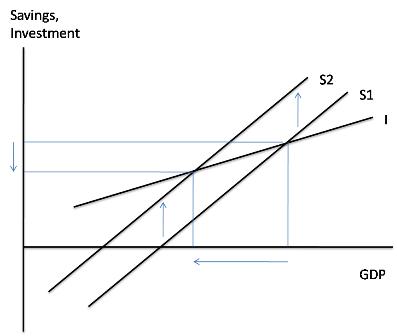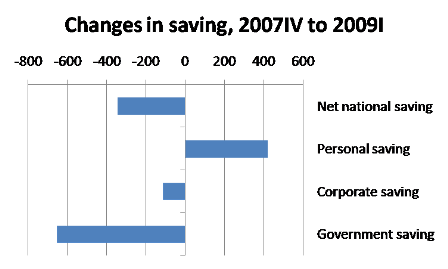One reason why the tax cut portion of the stimulus package didn't help the economy as much as a pure spending bill would have is that people save that money when we need them spending it... (posted on this front before)
The paradox of thrift — for real
The paradox of thrift is one of those Keynesian insights that largely dropped out of economic discourse as economists grew increasingly (and wrongly) confident that central bankers could always stabilize the economy. Now it’s back as a concept. But is it actually visible in the data? The answer is, and how!
The story behind the paradox of thrift goes like this. Suppose a large group of people decides to save more. You might think that this would necessarily mean a rise in national savings. But if falling consumption causes the economy to fall into a recession, incomes will fall, and so will savings, other things equal. This induced fall in savings can largely or completely offset the initial rise.
Which way it goes depends on what happens to investment, since savings are always equal to investment. If the central bank can cut interest rates, investment and hence savings may rise. But if the central bank can’t cut rates — say, because they’re already zero — investment is likely to fall, not rise, because of lower capacity utilization. And this means that GDP and hence incomes have to fall so much that when people try to save more, the nation actually ends up saving less.
The theoretical picture looks like this:

The line labeled I shows how investment spending depends on GDP. S1 is the original savings-GDP relationship; it shifts up to S2. The effect of this upward shift in desired savings at any given level of GDP is, paradoxically, a fall in actual savings and investment.
What does this look like in actual data? Strictly speaking, the figure above shows an economy without trade. If you add in imports and exports, the paradox of thrift becomes less likely, because you country’s reduced consumption comes partly at the expense of imports rather than domestic GDP. So I wasn’t sure what it would look like for the United States.
But here are the changes in total net saving and its components between 2007IV, the last pre-recession quarter, and 2009I, from the BEA:

Sure enough, the sharp increase in personal saving has been accompanied by a decline in overall national saving — partly via reduced corporate savings, largely via increased public deficits.
One caveat: some of the decline in investment, and hence in saving,is due to disruption in the credit markets. Still, my sense is that the big reason for declining business investment, at least, is simply the fact that consumer demand has fallen — which is paradox of thrift in action.
One key implication of the fact that we’re living in a paradox of thrift world is the folly of demands that we reduce budget deficits in the near term. Slashing spending or raising taxes right now wouldn’t just deepen the slump — it would actually make us poorer in the future, too, because it would lead to lower overall saving and investment.
Now, we won’t always face the paradox of thrift. But right now it’s very, very real.
This is part of the reason the Bush tax cuts didn't work. As think progress noted a while back about the Rpublican tax policy...
But the tax cuts they championed proved to be extremely ineffective, leading to the slowest period of economic growth in decades.
Obama putthe tax cuts in for political "bipartisanship" (sic) points. And now we have to deal with the impacts of "tax cuts work everytime for everything" policy that Bush proved was wrong.
No comments:
Post a Comment